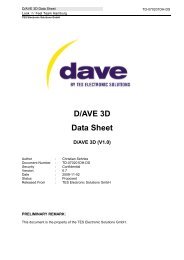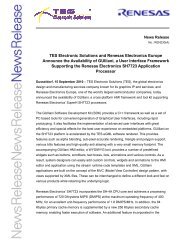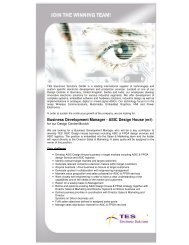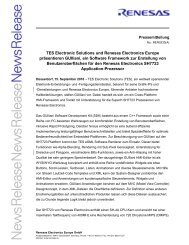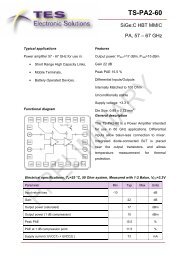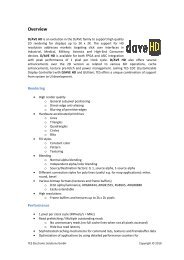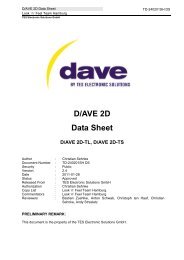D/AVE 2D Data Sheet - TES Electronic Solutions
D/AVE 2D Data Sheet - TES Electronic Solutions
D/AVE 2D Data Sheet - TES Electronic Solutions
You also want an ePaper? Increase the reach of your titles
YUMPU automatically turns print PDFs into web optimized ePapers that Google loves.
Approved<br />
TD-240201SH DS<br />
5. DISPLAY LIST FORMAT DESCRIPTION<br />
Display lists are stored using direct register to value mappings. There is almost no<br />
abstraction, so the structure of display list is quite simple. As D/<strong>AVE</strong> registers are always 32<br />
bit wide, list entries had to be at least of this size to be efficient. Because register indices are<br />
much smaller (6 to 7 bits) the storage format uses a packed notation to reduce the size.<br />
5.1 Overview<br />
• The list is stored in memory as a stream of 32-bit words.<br />
• It contains two different types of words: ‘address words’ and ‘data words’<br />
• The stream always starts with an ‘address word’<br />
• Each ‘address word’ can specify up to 4 (one byte each) register indices<br />
• The indices are read and interpreted lsb to msb (lowest byte first)<br />
• If less then 4 indices are required, remaining entries are filled with 0x80<br />
• An ‘address word’ is followed by 0-4 ‘data words’, one for each register index<br />
5.2 Example<br />
DWORD 0x11223344 // start of list 'address word'<br />
DWORD 0x00000000 // data word 1 (for register index 0x44)<br />
DWORD 0xffffffaa // data word 2 (for register index 0x33)<br />
DWORD 0x00000001 // data word 3 (for register index 0x22)<br />
DWORD 0x00ce0f20 // data word 4 (for register index 0x11)<br />
DWORD ...<br />
// next 'address word'<br />
This stream of dwords does essentially this :<br />
• write 0x00000000 into hw register 0x44<br />
• write 0xffffffaa into hw register 0x33<br />
• write 0x00000001 into hw register 0x22<br />
• write 0x00ce0f20 into hw register 0x11<br />
5.3 Special Cases<br />
There are a few additional operations besides filling registers necessary to drive the D/<strong>AVE</strong><br />
core, for example waiting for different busy signals. All special cases are encoded using<br />
address word entries equal to or above 0x80 (bit 7 set). There are no data words for such<br />
and the following indices, the stream continues with the next address word.<br />
The behavior is unspecified if an address word contains ‘gaps’ e.g. i3, 0x80, i2, i1.<br />
If special indices are used, no normal index must follow after them in the same address<br />
word.<br />
If the first index contains the special index 0xff, the following (second) index is interpreted as<br />
follows:<br />
bit 0 set : display list end<br />
bit 1 set : wait for pipeline write to framebuffer cache complete then issue a full pipeline flush<br />
(texture cache and framebuffer cache) and wait for framebuffer cache write to<br />
framebuffer complete (necessary before flip)<br />
bit 2 set : wait for pipeline write to framebuffer cache complete (necessary before fb format<br />
change and alpha channel blending change)<br />
Title<br />
D/<strong>AVE</strong> <strong>2D</strong> <strong>Data</strong> <strong>Sheet</strong><br />
Version<br />
2.9<br />
Date<br />
2012-08-01<br />
Sign Number<br />
TD-240201SH DS<br />
Author<br />
Christian Sehnke<br />
Page<br />
34/42



